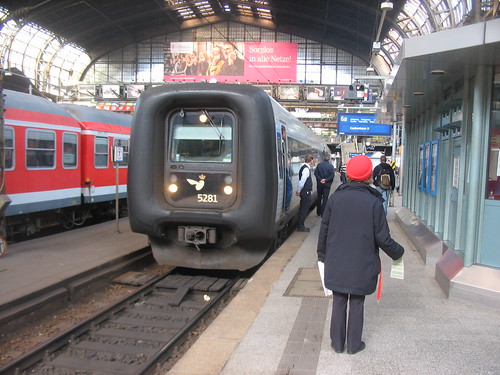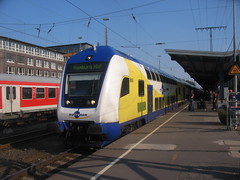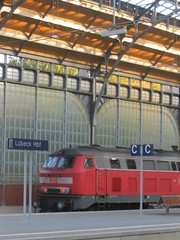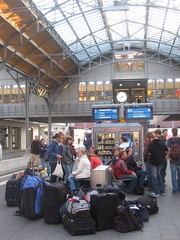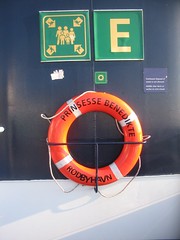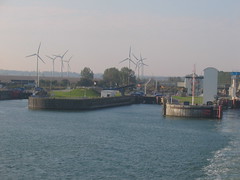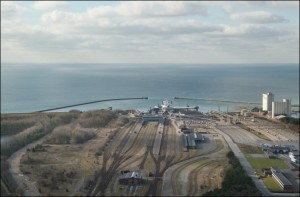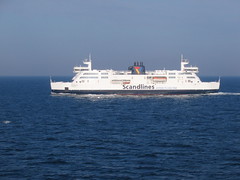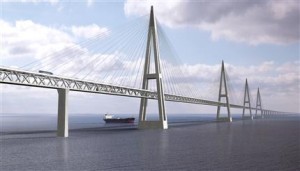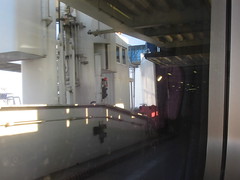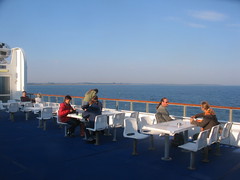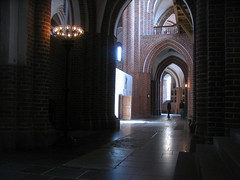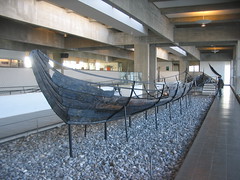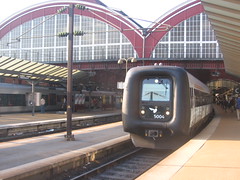HF Wiebe GmbH’s Hanomag 9445/1925 0-4-0T ‘Emma’, offering cab rides at the InnoTrans 2014 trade fair held in Berlin, Germany, during September 2014.
Germany
A visit to the Harzer Schmalspurbahnen
Some (rather badly scanned) photographs I took while on holiday in Germany in July 2003, along with an article I wrote for Eagle, the journal of the Cambridge University Railway Club.
![[Steam loco at water crane]](/images/rail/de-brocken2.jpg)
99 7238-1 takes on water at Drei Annen Hohne. 2003-07-18.
The famous Harz narrow gauge railway network is operated by Harzer Schmalspurbahnen GmbH. Owned by the various local authorities, it still provides scheduled steam services on the 131.24 km network, which became the first non-federally owned railway in the former East Germany on 1 February 1993. HSB declares its aim as to “preserve all three railways in the Harz region in their entirety as a tourist attraction, a monument to engineering, a facility for freight haulage and as a local transport facility”. HSB has 25 steam engines, six railcars, and 16 diesel locos.
We began our July 2003 visit to the Harz in Wernigerode. An attractive town, it looks rather like a German theme park might be built, with brightly-painted and half-timbered buildings. The Harz railways station is, as so often in Europe, located just outside the main station. Stepping off our DB train we could see smoke rising in the distance, but the DMU from Halberstadt had been 44 minutes late, so out priority was finding the Youth Hostel.
The hostel was a surprisingly respectable place, though a bus ride from the town centre, and not as well sign-posted as it could be! From the window of our room it was just possible to see passing steam trains through the trees. Dumping our bags we headed into town for dinner in the restaurant under the Rathaus – being a major tourist centre, there are plenty of dining options in the town. We wandered over to peer over the fence at the railway sheds, and bumped into a local who explained all about what Bismarck did in the dramatically-sited castle, but sadly our German wasn’t up to it.
The next morning we headed into town to photograph the 08:44 departure from Westerntor station cross a large level crossing outside the western gate to the town centre. We then walked to the main station to acquire tickets. The staff were well used to tourists, and with schoolboy-German and pointing at the map we were soon sold a suitable ticket. This was a €24 BrockenCard, valid for one return trip from any HSB station to Schierke and Brocken, and one other, non-Brocken, return trip within three days. A three day rover ticket costs €35, 5 days €40 and 7 days 50.00. Dogs under 20cm high go free, but bigger ones are half-fare.
We caught the 09:25 from Wernigerode to Brocken, hauled by 99 7238-1, and very busy with German holiday makers. The trains are formed of balcony carriages of a design common to the former-DDR’s narrow gauge lines. Riding on the balcony was popular, but Germans are averse to open doors. One chap held his nose to point out that the carriage might start to smell of steam if the door was left open, and leaving us to wonder why he was sat in the front carriage. It was clear that some of the Germans found their own insistance on keeping the doors close rather amusing, and they were slightly theatrical in closing doors after returning from trips to stand on the balcony!
The train arrived at the 1125m high Brocken station at 11:07, disgorging its passengers into the misty and slightly cooler surroundings. There is the typically German collection of sausage sellers, a restaurant and a hotel at the top of the 1142m high hill. The former military listening post is now a visitor centre with information on the national park, local wildlife and history. We bought postcards, but didn’t pay the €4 go in. There is a ban on using the train toilets between Schierke and Brocken, and we soon began to wonder if this was anything to do with charging people €0.50 for the ones on the hilltop! We wandered over to the railway to photograph 99 7242-3 hauling the 11:52 arrival, before boarding for the 12:08 back down.
![[Steam loco in trees]](/images/rail/de-brocken4-small.jpg)
2-10-2T locos 99 231 to 99 247 were built at Karl Marx Locomotive Factory in Babelsberg in the 1950s for use on the narrow-gauge Eisfeld – Schönbrunn, Gera-Pforten – Wuitz – Mumsdorf, Harzquer and Brocken lines. Carrying its former DR number, 99 7234 is heading up to Brocken, while the downhill train waits in the passing siding. Once the uphill train has passed, the downhill train reverses out of the siding back onto the main line, then heads forwards to Schierke. 2003-07-18.
Halfway to Schierke the downhill train runs into a siding, where it waits for the uphill train to pass. The downhill train then reverses out of the siding, before heading forwards again. Throughout the journey staff wandered up and down the train with baskets, selling small bottles containing some form of alcoholic beverage.
We got off at Schierke, to watch the trains pass and grab some currywurst and bottled black beer, and be impressed by the range of tacky witch-themed souvenirs in the station shop (the German witches who apparently meet on the Brocken seem to wear a lot less clothing than British ones!). We then took the 13:40, seven coaches and a van hauled by 99 7234-0, down to the junction at Drei Annen Hohne, where the station features a beer garden, and there is a tourist information centre. After 15:00 we had the now unusual sight of three scheduled steam trains waiting to depart in three different directions.
The loco from the Eisfelder Talmühle – Wernigerode train, which includes an open wagon fitted with seating for which a supplement is payable, is swapped with the loco from the Brocken – Nordhausen train. The Wernigerode – Brocken train keeps its loco.
At 15:33 we set off for Nordhausen behind 99 7236-5. At Elend there was a slight pause as the station cafe supplied mugs of drinks for the loco crew.
The countryside is heavily wooded, and many trees later we arrived at Eisfeld Talmühle, junction of the two routes. A diesel railcar connection arrived from Nordhausen and went off towards Steige. The station building seemed to be under reconstruction, and there was a collection of freight rolling stock in DR livery stood in a siding. We passed through Ilfeld, the northern limit of a more frequent service which provide about one railcar an hour to Nordhausen, but at irregular intervals.
Nordhausen – closed for rebuilding
![[Railcar]](/images/rail/de-nordhausen1-small.jpg)
There is short link between the HSB lines and the tramway in Nordhausen, allowing railcars to serve Nordhausen Nord, the bus and tram stop.
187 016-1 is one of four diesel-hydraulic railcars built to reduce costs on Alexisbad – Nordhausen Nord services and to provide school and commuter services between Ilfeld and Nordhausen. Partly paid for by the states of Thüringen and Sachsen-Anhalt, the 50km/h railcars were built at DB’s Halberstadt works and delivered from March to August in 1999. The design was developed using experience gained with prototype vehicle 187 015 which had been built in Wittenberge in 1996. (Photo 2003-07-18).
The HSB terminus in Nordhausen, just to one side of the DB station, gives the distinct impression of having seen better days. The one modern feature among the decay is the provision of a short link between the HSB and the town’s tram network. Branching off the HSB just before the station, this allows the HSB railcars to access the bus and tram stops in front of both railways’ stations.
The tram network comprises two lines electrified at 600 V DC. The 3.22 km Line 1 runs from the hospital in the north to the station in the south, the 4.55 km Line 2 runs from Parkallee in the northwest to Nordhausen East, crossing Line 1 in the town centre. During our stay much of the city centre was being dug up for rebuilding, and instead of serving the station via a large loop around the block the trams were terminating in a construction site a few minutes walk away.
The tramway was obviously having serious money spent on it, with some of the stops being modernised to light rail standards. In 2002 the town ordered 3 dual-mode Siemens Combino trams with 180 kW diesel engines, and from May 1 2004 these will operate an hourly service on a new Route 10 from the hospital, through the town centre and then under diesel power over the HSB lines to Ilfeld. We noticed that the southern end of the HSB also had very modern platforms, perhaps in readiness for the integration with the tramway.
![[Tram]](/images/rail/de-nordhausen2-small.jpg)
Three-section Siemens Combino tram number 105 tram negotiates the road and tramway rebuilding works in central Nordhausen. The tramway is operated by Stadtwerke Nordhausen. (Photo 2003-07-18).
The city has a fleet of 7 Siemens Combino trams, a mix of uni- and bi-directional models. No. 107 was carrying vinyls referring to the tramway in the Austrian town of Gmunden where it had recently been demonstrated. Only having doors on one side of most of the trams was awkward in the city centre, where rebuilding of the southbound track meant all trams were using the other line, making the doors inaccessible from the platform.
Tickets are bought from machines on board the tram, which seemed to be quite new as some locals were struggling with it. While we debated whether it was worth getting a four-journey ticket, a local thought we were confused and came to offer help. Then the tram stopped, luckily on a reserved track section, and the driver came back to join in!
The youth hostel is one stop from the northwestern terminus of Line 2, but within walking distance of the town centre; the tramway really is tiny. Outside the hostel were two sidings in a locked compound containing older trams, now displaced by the Combinos.
Like so many towns Nordhausen was devastated by air raids in WWII (V2 rockets were produced in a nearby labour camp), was perhaps unsympathetically rebuilt, and is only now being restored; it is quite odd to see a section of medieval city wall being built! The whole town gave the impression of being shut for rebuilding. We ate at a cheap bar round the back of the Rathaus, which was the only sign of life we could see. We weren’t unduly disappointed to be leaving Nordhausen the next morning, but I think it will be a reasonable place once they have finished building it, though with few attractions other than its transport network.
Down the pit
At 10:06 the following day we set off for Netzkater behind 99 7236-5. We had planned to change trains one stop further on at Eisfelder Talmühle, but on the way in we had spotted a mining museum with a collection of narrow gauge rolling stock, and a beer garden.
A tour of the mine was departing as we arrived at the museum, and after relieving us of €5 the ticket office simply gave us hard hats pointed towards the drift entrance. We dashed down after the tour group, for a 45 minute walk around the disused coal mine. The tour was in German, but if you have ever done a tour of a mine you can work out much of what was being said and fill in the gaps! Part of the tour is completely unlit, visitors having to feel their way forwards through the tunnels. There was a demonstration of a cable hauled incline inside the mine, then we returned tot he surface, where for €0.50 rides on a 60cm gauge man-rider train were available. A beer later we caught the 12:10 diesel railcar for Hasselfelde on the Selkatal line.
Limitations of GCSE German
All but one of the other passengers disembarked at Stiege, but we continued to Hasselfeld. The ‘genuine’ passenger left, and the driver retired to the station cafe. We wandered around the station yard, where a steam loco boiler is on display. A shed contains another loco, which we think is privately owned and non-operational. We then returned to Steige, where the passengers who had got off earlier got on again! There were now 13 passengers,and the other 11 seemed fairly genuine, rather than simply there for the ride. In contrast, all seven or so coaches of the trains on the Brocken line had been pretty full.
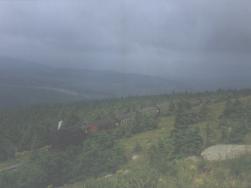
An uphill train approaches the Brocken summit. 2003-07-18.
Numbers had thinned to four by Siberhütte. As we approached the station a stout gentleman in a bright pink shirt could be seen rushing towards the station, followed by a snaking line of 10 hikers. Unfortunately the train left the station before he made it to the platform. This left us with a problem, as I was off school during the “bang on the cab door and tell the train driver he had left the passengers behind” module of GCSE German. We pointed out to the other two passengers what had happened, and after some hesitation they went to establish communications with the driver. We stopped some distance beyond the station, and I hung out of the window to wave and shout at the hikers, who came trotting along the track behind us to catch up.
We got off at Alexisbad, the junction for the Harzgerode brach, and took the change to sample the local apple wine. A steam train arrived from Gernrode, and we caught it up the steeply graded branch. Many of the passengers seemed to be enthusiasts, and there were a few British people on board. A the terminus there was just time to glance into the castle courtyard, then it was time to head back down to Alexisbad, and change for a steam service to Gernrode.
The station area at Gernrode cannot be considered one of Germany’s greatest scenic delights. After ascertaining that the semi-derelict structure opposite the HSB terminus really was the DB station, and inferring from the presence of another, local-looking, passenger that there might really still be a train service, we had the best part of an hour’s wait for our two-car DMU. This took us to the very attractive town of Quedlingburg, which has an impressive gothic-style station, and a centrally-located – and this time well sign posted – half-timbered youth hostel where we were given a room in the attic.
Visiting
The Harz railways are well worth a visit. Wernigerode is geared up for tourists, and the Brocken line is very popular. The use of steam over the whole system can feel slightly “preserved”, but I felt the Selketal line had a slightly more genuine feel to it, with real passengers, and the railcars certainly provide a real service.
The one thing to beware of when planning a trip is that south of Drei Anne Hohne the trains are not very frequent, with four services per day over some stretches of line. The pattern of through trains is quite complex, and a trip over the whole network does require some planning.
HSB’s official website at gives full timetables, details and histories of the lines, and enthusiast oriented information on the rolling stock in both German and English.
As the Vogel flies
Or, to bee or not to bee
The “Bird-flight line” between Germany and Denmark uses one of the last passenger train ferry services in Europe, providing a direct route from Hamburg to Copenhagen “as the bird flies”.
There’s no way the ticket machine is going to be able to cope with this, I thought, giving it a go anyway. What hope is there of getting a foreign machine to sell a future-dated ticket for a cross-border trip, on a service which is partly reservation-only, includes a ferry, and calls at a station which doesn’t exist – in the middle of the sea? With a break of journey in the next country. Oh, and a foreign credit card.
But Deutsche Bahn’s latest technology beats the our old Quickfares, and a couple of minutes later I was leaving Lübeck station clutching enough paper to keep the forest products industry in business for the next week; the ticket, two reservations, a receipt and a list of timings. All issued in English, and after offering me timetable information and a choice of fare options.
Back in September 2007 I’d got an invitation to the opening of a new bit of metro line in Denmark, and having some holiday to use up I thought I’d take a route which was a bit more scenic than a tin box direct from Gatwick to København.
The Danish and German governments had recently agreed to build a bridge across the Baltic to replace the current Fehmarn Belt train ferry, so this seemed a good opportunity to sample the sea crossing – not that there is too much of a rush, as the bridge won’t open until 2018, if it happens at all.
Step one was getting to Germany. Eurostar hasn’t really caught on to one-way trips, and while DB’s whizzo ticket machines might be wonderful their sleeper train website was sulking, so a search online found me a “how do they maintain the planes at that price?” flight to Bremen with everyone’s favourite Irish airline, leaving darkest Essex the next day.
A mere 15 min after landing in Bremen I was on the tram stop outside the air terminal. Just 20 min after landing I was back in the airport seeking somewhere to buy a ticket, and only 25 min after landing I was on a tram to the Hauptbahnhof. From here I caught a couple of double-deck trains via Hamburg Hauptbahnhof to the strangely deserted city of Lübeck, and its handily central youth hostel – staying in Lübeck meant the next morning’s departure time would be at a more civilised hour than if I joined the København train at its start point in Hamburg.
The railway from Hamburg to Lübeck is currently being electrified – by the time you read this, it probably will have been – which will bring the demise of the “rabbit-ear” exhaust Class 218 diesel locos which currently power double-deck push-pull trains on the route. On a previous visit in March 2007 the station had been a building site, but by September the overall roof had been completed, and the heavily-rebuilt station had a modern and efficient air about it.
I’d seen the Hanseatic city’s sights before, so it was time for a meal, ein bier, and bed. Thanks to the wonderful ticket machine I was already booked on the next day’s 08:07 train to Denmark.
Leaving Lübeck
In September the Hamburg to København service was operated with Danish State Railways’ IC3 DMUs, three-cars units with “rubber ring” ends (and not to be confused with the German ICE3 high speed trains). Built by ABB Scania before it became Adtranz and then Bombardier, the 180 km/h units aren’t the prettiest things on rails, but the spacious interior makes the most of a loading gauge somewhat larger than ours. With the December 2007 timetable change DB’s ICE-TD tilting inter-city DMUs have been transferred to the route, the national railway finally having found a home for what have provided troublesome trainsets (one got dropped and bent in a depot accident, like the unfortunate Hull Trains Pioneer DEMU).
Reservations are compulsory on the German leg of the trip to Denmark, but my seat was firmly occupied so I bagged a spare seat across the aisle; after a few seconds of the “music” from a fellow passenger’s headphones I decamped to the next carriage.
We left Lübeck slightly late, and headed north for an uneventful 89 km trip across a flat and nondescript landscape. The final stretch of this line was built specifically for international trains, as part of a grand plan to significantly shorten the time needed to travel between eastern Denmark and Germany.
Making a Bee Line
By the early twentieth century it had become clear that better links were needed between København and Germany. One of the travel options was to take a train to the Danish port of Gedser, then make a long sea crossing to Warnemünde on the north German coast. The alternative was to take a train across Sjælland (Zealand) from København to the Storebælt (Great Belt). Here you caught a ferry across the strait to the next island, Fyn, which was then crossed by train until you hit the Lillebælt (Little Belt). A second ferry then took you on to the Jylland (Jutland) peninsular, from where you could get a train south to Germany. A bridge across the Lillebælt was opened in 1935, permitting a through rail journey once you were west of the Storebælt, but that still had to be crossed by ferry and it was all a bit of a long way round.
By the end of the 1930s plans had been firmed up for new link, which would use a relatively short sea crossing between the Danish island of Lolland and its German opposite number Fehmarn. New bridges would link each island to the respective national road and rail networks. Joining together the islands dotting the shortest route across the Baltic, this route is in effect a straight line between Hamburg and København, and could even be stretched, with some cartographic licence, on to Stockholm and Köln. The proposed route became known as the Vogelfluglinie in German or Fugleflucts Linien in Danish, meaning Bird Flight Line, in the sense of “as the crow flies”. This sometimes gets translated into English as the “Bee Line”.
The first step was the opening of the 3.2 km Storstrøm bridge in 1937, providing a road and rail link between Sjælland and the island of Falster, but further progress was interrupted by the outbreak of war. The plans were dusted off again after the German occupation of Denmark, and in 1941 the Danish parliament agreed to construct the rail and motorway links for their end of the scheme. Work began immediately, and about 13 km of civil works were completed at a cost of 7.7m krone before being put aside for another day in the face of more pressing matters.
Peace created a problem for the long eastern sea route from Gedser to Germany. The ports of Warnemünde and Sassnitz were now in East Germany, and transit to the areas under the control of the western powers was no longer possible. Traffic from Scandinavia to western Europe had to go round via Jylland, and the Storebælt ferries couldn’t cope with demand.
To keep things moving a temporary ferry service was introduced on 14 July 1951, running from Gedser to a new facility built at Grossenbrode in what was now West Germany.
By 1958 West Germany had recovered to the extent that it was in a position to take another look at the plans for the Bird Flight Line, and a new Danish act of parliament approved the re-start of work on a revised scheme.
At the German end the railway from Lübeck to Grossenbrode was resignalled and upgraded for higher speeds, while 18 km of new line was built to a new ferry port at Puttgarden on the island of Fehmarn. The railway crosses from the mainland on a 960 m bridge, which includes a 250 m arched main span taking the single track line and a parallel road 23 m above sea level. Work on the bridge began in January 1960, and it opened in April 30 1963, with the island’s ferry service closing the same day.
A second ferry port was built at Rødbyhavn, near the town of Rødby on the Danish island of Lolland. A meandering private railway already ran there, but the new terminal was linked to the Danish State Railways (DSB) network with the construction of a line running for 37 km straight across the island. A swing bridge carried the new line above the Goldberg sound and on to the neighbouring island of Falster. At Nykøbing it joined up with the railway to Gedser, the port for the temporary service to West Germany which the Bee Line would replace. The new line was built without level crossings, instead needing numerous bridges because of the flat landscape.
The German and Danish ferry ports were just 18 km apart by sea, a substantial saving on the previous 69 km route from Gedser to Grossenbrode. This cut a København – Hamburg trip to just 6 h 15min, compared with 9h 20min via the Great Belt or 8 h via Gedser and Grossenbrode. It now takes about 4½h.
The Bird Flight Line service was inaugurated on May 13 1963, using DB ship Deutschland and DSB ship Kong Frederik IX, which were transferred from the temporary Grossenbrode to Gedser route. Also transferred was Theodor Heuss, which had entered service on November 1957.
The route proved a success, and traffic continues to grow. Modern ferries operated by Scandlines now leave each port every half hour around the clock, and are timetabled to take 45 min for the crossing. Not every sailing carries a train – there are six Hamburg – København train pairs a day.
In June 2007 the Danish and German governments finally agreed to build a 19 km bridge to replace the ferries. Work is planned to start in 2011 and the bridge is scheduled to open in 2018, but this is dependent on Denmark stumping up the money; the Germans have said that if the Danes want a bridge they will happily go along with it, but they won’t pay for it.
All at sea
The train stopped briefly in the station at Puttgarden, before running forward into the bowels of the ship quite simply and unexcitingly, at least from the passengers’ point of view. The train doors opened, and passengers started to wander off; it was obvious that I wasn’t the only one who was unsure as to whether he could his bag on the train. The train parks on the car deck, with a lorry behind it, and passengers mingle with road users as they head upstairs to the lounges.
Forget romantic notions of chaps in horned helmets [yes, yes, I know] taking to the high seas in this part of the world. Built in Denmark in 1997, Prinsesse Benedikte is a sort of floating motorway service station, with bars, a closed restaurant and a dedicated lounge for lorry drivers. The duty free shops were closed, perhaps permanently.
Having walked round the ship in both directions I headed to the buffet, joining the locals in a game of seeing how much hot coffee it is possible to get into a serve-yourself paper cup without burning yourself.
Up on the inappropriately-named sun deck passengers were watching the busy maritime traffic of this corner of the Baltic. There are ships visible in every direction, but also lurking out here amongst the waves is an honorary railway station, Puttgard MS. A figment of the ticketing system, the notional Mittlesea station allows holders of tickets for one country to buy a ticket for the other country, starting right at the international border.
Arrival in Denmark is as unexciting as the departure from Germany, the ferry slowing past the breakwaters as it enters Rødbyhavn. To save time at the ports the ships are double-ended, with a bridge and doors at both ends so there is no need to turn vessels round.
Denmark
There was an obvious movement of passengers towards the car deck as we approached Danish terra firma. The train is the first vehicle off the ship when the doors open, passing through a vast area of derelict sidings left over from the days when borders were real borders. The station was built for 15-coach loco hauled trains, rather than today’s three car DMUs, and yard tracks were laid out so that a complete ferry load of wagons could be in position and waiting to be shunted on board as soon as the ferries docked.
All rail freight traffic now goes round via the Storebælt and Jylland, with the Øresund bridge as newest link in a chain which enables freight to be hauled from Sweden to through to Germany with just one multi-voltage loco.
The scenery continues to be unexciting, with minor interest provided by the bridges between the islands. The Guldborg Sound between Lolland and Falster is crossed on a precast concrete bridge, actually two parallel structures, one for the single track railway and one (which is itself two interlinked structures) carrying the road. Trains are now back on the original line to Gedser, and cross to Sjælland on the 3.2 km road and rail Storstrøm bridge built in 1937.
At Ringsted we join the main line from Jylland to København, and not long after we pull into the ancient ecclesiastical capital Roskilde, where there is an impressive cathedral. The past few centuries worth of Danish monarchs are buried here in neat numerical order, including the railway enthusiast Frederik IX whose final journey to the cathedral in 1972 was steam-hauled; his wife left instructions to use the same locos for her own funeral in 2000.
The sea crossing on the Bird Flight Line is efficiently dull, but the glory days of Danish maritime matters can be recreated at a museum by down the shore in Roskilde. Five Viking ships when been extracted from the seabed and put on display, and replicas take people out into the fjord to experience a bit of Viking life (note to museum curators: I’m sure the Vikings were all into trade and poetry, but I want longships and pillage for my krone).
The ride onwards to København on an EMU packed with school children was uneventful, and no-one even asked to see my heap of tickets.
References
- Train Ferries of Western Europe, P Ransome-Wallis, Ian Allan 1968
- The Rodby-Fehmarn Route (The Bee-Line), K Gulstad, Chief Permanent Way Engineer, DSB. Railway Gazette, 18 May 1962, pp565-571
Oberweißbacher Bergbahn
A piggy-back ride up the hill
One of Germany’s oddest railways is a piggy-back funicular, part of a three-line network of rural railways. In the hot summer of 2003 I went for a ride, and wrote another article for Eagle, the journal of the Cambridge University Railway Club.
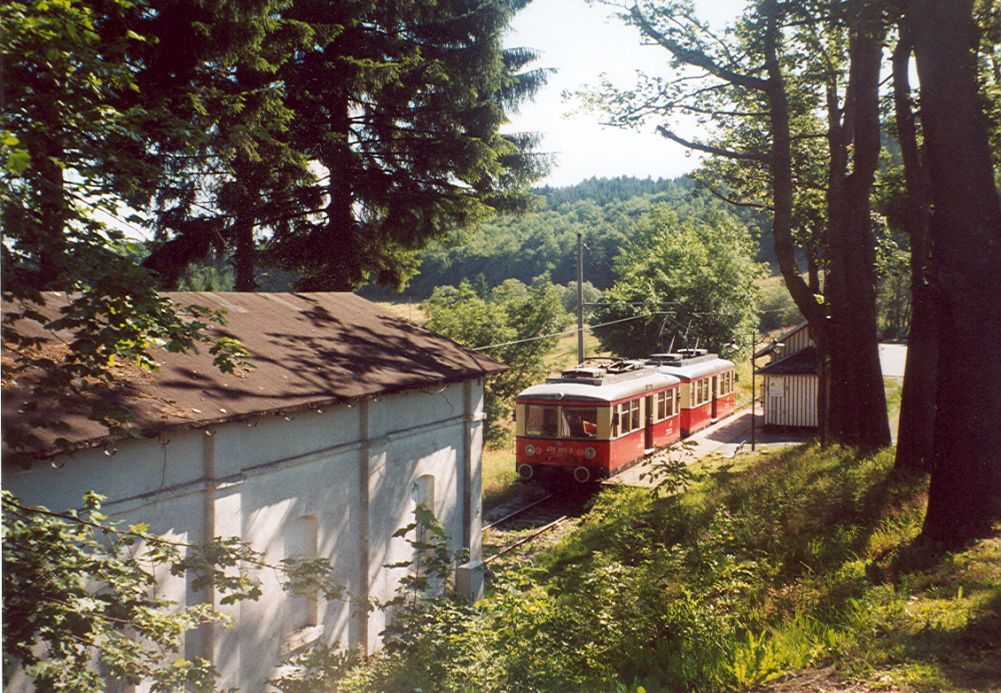
In Britain we tend to think of funicular railways in terms of the Edwardian cliff lifts gracing our seaside towns, but deep in the forests of Thüringen is something rather different. One of the strangest lines operated by Deutsche Bahn, the Oberweißbacher Bergbahn is a 1.4 km broad-gauge funicular which climbs 323m up a wooded hillside. Inland funiculars are not usual in the more vertiginous parts of the Continent, but what makes the Oberweißbacher line special its very unusual (though I dare not suggest unique!), piggy-back design. Seemingly little known outside Germany, the Bergbahn deserves wider fame, both for its unusual arrangement and the short electric railway at the summit.
I first came across the Bergbahn in 2003 while flicking through a copy of Eisenbahn Magazin, a German monthly publication for railway enthusiasts. There was short report about the reopening of the Bergbahn on 15th December 2002 following a major refurbishment, with a photo of the piggy-back car. Thinking it might be some kind of spoof, I looked up the line in Cook’s European Timetable and then on the internet – there is a comprehensive website about the Bergbahn in German and English – and soon decided it would be on my itinerary for a visit to Germany planned for July 2003.
Going there
Located in the Free State of Thüringen, one of the Länder in what was once East Germany, the Bergbahn is somewhat remote, and while it is not difficult to get there by train, some forward planning ensures that one can end up somewhere sensible afterwards.
Leaving the Nürnberg to Berlin ICE train at Saalfeld, there is time for a quick look across the tracks to a small loco depot, where one of the bays of the roundhouse appears to have the front end of a diesel loco built into a blanking wall! From Saalfeld a cross-country branch runs to Erfurt, and our train was formed of 621 024-5, a single car DMU built by De Dietrich and LHB (now part of Alstom) for use in Germany and France (where it is Class X73500). Another change is necessary 16 minutes later at Rottenbach, where we boarded 641 019-5, one of two 120 km/h De Dietrich/Alstom class 641 railcars which are dedicated to the 25 km Schwarzatal branch.
The branch, the funicular and the electric railway at the top of the hill together form the Oberweißbacher Berg- und Schwarzatalbahn, one of four self-contained regional networks created by DB AG on 1st January 2002. The infrastructure and operation are integrated, the rolling stock is dedicated to the route, and OBS has 28 staff providing a degree of local control and management. The 42 minute journey along the Schwarzatalbahn passes up the heavily wooded valley of the river Schwarza to the terminus at Katzhütte. Sections of the permanent way had been recently relaid, with disused goods yards which had once served now derelict factories losing their connection to the rail network. There are eight stations on the route, including Obstfelderschmeide, the lower station of the Bergbahn. Plandampf ays are held each year, when steam locomotives work service trains along the line, which opened in 1900.
Katzhütte is a small place, spread out along the valley by the river and road. The youth hostel was almost empty, with just a handful of Germans and the obligatory Japanese visitor, intently studying his guidebook (which no doubt listed every detail of the Bergbahn). Unusually, the hostel warden spoke no English, so the rusty remains of GCSE German were dusted off. Across the road from the hostel was a pub, serving the usual chunks of pig atop a mountain of cabbage. The occupants of the village’s second pub were intently playing cards, but we received a more vigorous welcome from the local midges.
Going up
The next morning we caught 641 020-3 down the branch for the 16 minute ride to Obstfelderschmeide, the lower end of the funicular. The Bergbahn was originally built to provide a rail link from the valley bottom to the villages on the plain above. Access via a twisting road up the valley sides had been difficult until the funicular provided a link to the outside world, opening for goods traffic on 15th January 1922 and to passengers on 15th March the following year. The 1 387.8 m long Bergbahn has the common funicular layout of two cars running on a single track line with a passing loop in the middle. More unusually the tracks split again at the bottom station, the left-hand route when seen from the valley bottom having a roof over it. On this track is a conventional, if wide, funicular vehicle which we rode up the hill. It has banked seating for 100 passengers, and an empty weight of 26 tonnes.
The most distinctive feature of the Bergbahn is the other car, which travels on the right hand track at Obstfelderschmeide and through the passing loop. This 25 tonne vehicle has a triangular wedged-shape, providing a level platform on top of which sits, piggyback style, a 9.2 tonne four wheel carriage which 72 passengers can travel in. This carriage was formerly used on a light railway between Schleiz and Saalburg, and it was adapted for dedicated use on the funicular in 1972. It can be rolled off the transporter vehicle, leaving the platform free to carry other stock up the funicular. A siding from the Katzhütte line leads to a small turntable, where single wagons or small carriages of up to 27 tonnes can be rotated 90 degrees and manoeuvred onto the piggyback
car.
The Bergbahn operates every 30 minutes, more frequently than the two trains each way every two hours (it isn’t simply hourly) on the branch line, and, being in Germany, the funicular departures are timed to connect with the trains. In March 2004 the funicular was adapted to provide wheelchair accessibility. A conductor travels on board, and can give a talk on the history of the line, well rehearsed to fit the 18 minute duration of the trip. The descending vehicle is passed in the middle, with the inevitable waving between passengers. To avoid the need for moving points the vehicles have double flanged wheels on their outer wheels but no flanges on the inner wheels, the inner rails through the loop providing support but not guidance. The gradient varies between 24% and 25%, and the track curves to the left as it climbs. The top station at Lichtenhain is 323 m above Obstfelderschmeide, and houses the electrically-powered winding gear for the funicular. Inside the station is a small display of old photos.
Going along
Outside the funcular’s fine trainshed is the platform used by trains on a standard gauge line which runs for a further 2.5 km to Cursdorf. The only rail link from this line to the outside world is via the piggy-back wagon to the valley bottom. Stock can be rolled onto the piggy back vehicle via another turntable, this time situated on the standard gauge running line rather than a siding. The turntable and also gives access to a small workshop. The line to Cursdorf is electrified at 600 V DC, and the half-hourly service is worked by three electric railcars dating from 1923, assembled from parts used on Berlin S-Bahn trains. Six minutes after the funicular had arrived we set off on board 479 205-7, with the 24 seats in each of the two cars of the train to ourselves. The 10 minute ride to Cursdorf passes through a rural landscape of fields, trees and the ubiquitous wind turbines, with one intermediate station at Oberweißbach. There didn’t seem to be much to see at the terminus, and not having time to explore the country walks signposted with the usual Teutonic thoroughness, we simply caught the train back for a look at the top station, travelling in the other car, 479 203-2. At Lichtenhain a few passengers were waiting for the trip down in the piggyback car.
Going back
We caught 641 020-3 from Obstfelderschmeide back to Rottenbach. The DMU had a first class area with eight, empty, seats, the only difference from the 55 in standard class seemingly being a partition. The driver was responsible for checking tickets, leaving the cab at some stations to walk through the trains. Many of the passengers were children.
In 2003 the Bergbahn received around 200 000 visitors, making it the second most popular attraction in Thüringen.
More information
- Everything you might want to know about the Oberweissbacher Bergbahn, in German and English.
- Deutsche Bahn
- Later in the week we visited the justly famous Harz narrow gauge railway network.
![[Loco in the mist]](/images/rail/de-brocken3-small.jpg)
